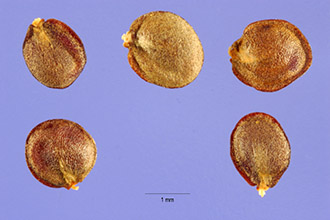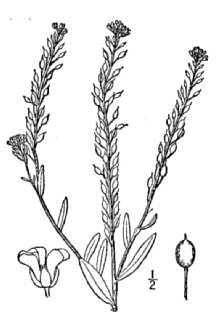Hoary Alyssum
Scientific Name: Berteroa incana (L.) DC.

| General Information | |
|---|---|
| Usda Symbol | BEIN2 |
| Group | Dicot |
| Life Cycle | AnnualBiennial, Perennial, |
| Growth Habits | Forb/herb |
| Native Locations | BEIN2 |
Plant Guide
Alternate Names
Common Names: false hoary madwort, hoary berteroa Scientific Names: Synonyms for Alyssum incanum L.
Description
General: Hoary alyssum is a member of the mustard family (Brassicaceae). Native to east-central Europe and western Asia, it is an annual forb found to be a biennial or short-lived perennial under specific circumstances (Jacobs and Mangold, 2008). It has a slender tap root capable of deep soil penetration. The lower leaves are linear, becoming broadest at the tip, up to two inches in length. As the plant matures, the lower leaves wither as stems, smaller upper leaves, and flowers begin to form. The small flowers are white with four deeply notched petals clustered at the stem tips. Flower stems are erect or semi-erect and typically branched at the top. The flower stems can vary in height up to 30 inches. The stems, leaves, sepals, and seed pods all have star-shaped hairs (Lackschewitz, 1991). Hoary alyssum reproduces by seed. Seeds can germinate from early spring to late fall, limited mainly by open space and water. Seedlings that establish in spring to early July can flower and produce seed by early fall. Seedlings that establish in late July or later will remain as rosettes and produce flowers and seeds the following year. Germination is determined mostly by water availability. Short-lived perennial reproduction has been documented when the plant regrows after an alfalfa (Medicago sativa) cutting (Jacobs and Mangold, 2008). Seed pods contain 4 to 12 dark reddish-brown, small lens-shaped seeds with narrow wings divided into two rows within each pod (Lackschewitz, 1991). Distribution: Hoary alyssum is an introduced species throughout North America. It is believed to have been introduced in contaminated alfalfa and clover seeds. It grows throughout Canada and the northern United States at elevations less than 9000 feet (Jepson, 2012). For current distribution, please consult the Plant Profile page for this species, Berteroa incana, on the PLANTS Website. Habitat: Hoary alyssum is found on dry, disturbed soils and heavily grazed sites. It will likely invade alfalfa, clover (Trifolium spp.), and birdsfoot trefoil (Lotus corniculatus) pastures, especially on sites with poor soil fertility. However, it can be found growing in many different plant communities. It has been found along roads, railroads, trails, stream gravel bars, lake edges, and in lawns, farmyards, vacant lots, heavily grazed pastures and rangeland, and hay meadows (Jacobs and Mangold, 2008).
Adaptation
Hoary alyssum is adapted to temperate continental climates, characterized by cold winters and hot, dry summers, but is found throughout much of the United States. Fall seedlings and immature plants are resistant to winterkill. Flowering plants are resistant to summer drought. It grows well on sandy or gravelly soils with poor soil fertility and is most prolific on open sites that are dry or disturbed. It is commonly found on limestone and calcareous substrata, but less often in acidic soils (Jacobs and Mangold, 2008).
Uses
Livestock feed is not a recommended use. Livestock will either reject the plant or seek out more palatable options. In addition, hoary alyssum is toxic to horses when it constitutes more than 30% of their forage. Overgrazing, especially of desired forage, can lead to bigger infestations and spread of this species. Natural Resources Conservation Service Plant Guide Drawing of Berteroa incana (left). Close-up of seeds (right). Images: USDA-NRCS PLANTS Database The flowers do not benefit pollinator habitats as this plant has been found to attract few pollinating insects in North America. In the Ukraine and Germany, it is used as vegetative cover in mining and municipal wastelands (Jacobs and Mangold, 2008).
Status
Weedy or Invasive: Hoary alyssum may become weedy or invasive in some regions or habitats and may displace desirable vegetation if not properly managed. This plant is an aggressive invader in fields, rangeland, and pastures. It is listed as a noxious weed in California, Colorado, Idaho, Michigan, Montana, Oregon, and Washington (Center for Invasive Species and Ecosystem Health, 2018). Hoary alyssum is not a threatened or endangered species or a wetland indicator species. Please consult the PLANTS Website (http://plants.usda.gov/) and your state’s Department of Natural Resources for this species current status (e.g., threatened or endangered species, state noxious status, and wetland indicator values).
Planting Guidelines
Hoary alyssum is an undesired, invasive species. It should not be planted or propagated under any circumstances in North America. Contact your local Extension specialist or county weed specialist to learn how to best manage hoary alyssum.
Management
See control below.
Pests and Potential Problems
See environmental concerns below.
Environmental Concerns
Concerns
Concerns
Hoary alyssum decreases forage value because the woody stems of mature plants are low in crude protein and digestible carbohydrates. A horse’s diet consisting of 30% or more hoary alyssum can cause toxicity leading to laminitis, limb edema, diarrhea, intravascular hemolysis, and hypovolemic shock. The ability of hoary alyssum to persist under dry conditions and its continuous flowering and fruiting enables it to compete with native plants on range and wildlands and reduce biodiversity. In Minnesota it has been implicated in the reduction in species richness of pollinator communities because it attracted a minimal number of pollinating insects (Jacobs and Mangold, 2008).
Control
Please contact your local Extension or county weed specialist to learn what control methods work best in your area. Always read label and safety instructions for each control method. Trade names and control measures appear in this document only to provide specific information. USDA-NRCS does not guarantee or warranty the products and control methods named, and other products may be equally effective. Herbicide: Hoary alyssum can be temporarily suppressed using 2,4-D applied at label rates. Spring applications when plants are actively growing and prior to bolting will be most effective. Repeated applications will be needed to target plants establishing from the seed bank. Reports indicate metsulfuron applied at 0.5-ounce product per acre will control hoary alyssum. Other sulfonylurea herbicides including chlorsulfuron and trisulfuron products as well as dicamba, and imazapic products may also be effective. Glyphosate, a non-selective herbicide, will also control hoary alyssum (Jacobs and Mangold, 2008). Mechanical: Mowing infrequently will not control hoary alyssum and may increase infestations by removing a shading canopy and spreading seed pods. Regular, repeated mowing to a 6-inch or lower stubble height may reduce seed production of hoary alyssum, and when combined with irrigation and nutrient management, increase the vigor of desirable plants. Shallow tilling that severs the tap root below the root crown will kill hoary alyssum plants. However, this type of disturbance will favor hoary alyssum regeneration from the seed bank. Multiple tilling or tilling followed by application of herbicide to target establishing seedlings can be used to exhaust the supply of viable seeds in the soil. Tilling is only recommended in cropland or in combination with seeding perennial competitive plants. As with any mechanical treatment, equipment should be washed after working in an infestation and before it is used on weed-free areas. Hand pulling that removes the root crown is an effective method to temporarily reduce hoary alyssum on small-scale infestations and scattered plants that are either newly invading or persisting after herbicide treatments. Pulling or grubbing the root crown is most easily accomplished when the soil is moist, and a shovel can be used to pry-up tap roots. When the soil is dry, the plant tends to break off above the root crown enabling its regeneration. Pulling should be repeated as plants regenerate from the seed bank or from remaining root crowns. Plants with seed pods should be sealed in plastic bags and disposed of in the trash to prevent seed spread.
Seeds and Plant Production
Plant Production
Plant Production
Do not intentionally propagate seeds and plants of hoary alyssum as it is an invasive species, Hoary alyssum has an extended flowering period, producing seeds while flowering, making it difficult to control if not properly managed, To reduce the chances of reproduction, it is recommended that herbicides be applied before flowering begins, However, it was found that applying chemical treatments after flowering has occurred will result in reduced seed viability when compared to untreated plants (Menalled et al,, 2018), , Use soil moisture sensors to measure the soil moisture of Hoary Alyssum.
Literature Cited
Center for Invasive Species and Ecosystem Health. 2018. Hoary alyssum. Warnell School of Forestry & Natural Resources, University of Georgia, Athens, GA. URL: https://www.invasive.org/browse/subinfo.cfm?sub=5177 (accessed February 2020). Jacobs, J. and J. Mangold. 2008. Ecology and Management of Hoary Alyssum [Berteroa incana (L.) DC]. Technical Note MT-22. USDA-NRCS, Bozeman, MT. 7p. Jepson Herbarium. 2012. Berteroa incana. University of California, Berkeley, CA. URL: https://ucjeps.berkeley.edu/eflora/eflora_display.php?tid=15612 (accessed February 2020). Lackschewitz, K. 1991. Vascular Plants of West-Central Montana, Identification Guide, General Technical Report INT-277. USDA-USFS, Intermountain Research Station, Ogden, UT. 202p. Menalled, U., S. Davis, and J. Mangold. 2018. October Weed Post: Are invasive plant managers reducing viable seed production of hoary alyssum with herbicides? Montana State University Extension, Bozeman, MT. URL: http://msuinvasiveplants.org/extension/2018_october.html (accessed February 2020). USDA, NRCS. 2020. The PLANTS Database. National Plant Data Team, Greensboro, NC 27401-4901 USA. URL: http://plants.usda.gov (accessed February 2020). Citation Noack, R., M. Pokorny, J. Jacobs, and J. Mangold. 2020. Plant Guide for hoary alyssum (Berteroa incana). USDA-Natural Resources Conservation Service, Bridger Plant Materials Center, Bridger, MT 59014. Published: April 2020 Edited:16 March 20JLD For more information about this and other plants, please contact your local NRCS field office or Conservation District at http://www.nrcs.usda.gov/ and visit the PLANTS Website at http://plants.usda.gov/ or the Plant Materials Program website: http://plant-materials.nrcs.usda.gov. PLANTS is not responsible for the content or availability of other Websites. In accordance with Federal civil rights law and U.S. Department of Agriculture (USDA) civil rights regulations and policies, the USDA, its Agencies, offices, and employees, and institutions participating in or administering USDA programs are prohibited from discriminating based on race, color, national origin, religion, sex, gender identity (including gender expression), sexual orientation, disability, age, marital status, family/parental status, income derived from a public assistance program, political beliefs, or reprisal or retaliation for prior civil rights activity, in any program or activity conducted or funded by USDA (not all bases apply to all programs). Remedies and complaint filing deadlines vary by program or incident. Persons with disabilities who require alternative means of communication for program information (e.g., Braille, large print, audiotape, American Sign Language, etc.) should contact the responsible Agency or USDA's TARGET Center at (202) 720-2600 (voice and TTY) or contact USDA through the Federal Relay Service at (800) 877-8339. Additionally, program information may be made available in languages other than English. To file a program discrimination complaint, complete the USDA Program Discrimination Complaint Form, AD-3027, found online at How to File a Program Discrimination Complaint and at any USDA office or write a letter addressed to USDA and provide in the letter all of the information requested in the form. To request a copy of the complaint form, call (866) 632-9992. Submit your completed form or letter to USDA by: (1) mail: U.S. Department of Agriculture, Office of the Assistant Secretary for Civil Rights, 1400 Independence Avenue, SW, Washington, D.C. 20250-9410; (2) fax: (202) 690-7442; or (3) email: program.intake@usda.gov. USDA is an equal opportunity provider, employer, and lender.

